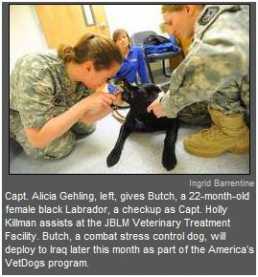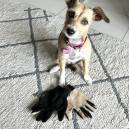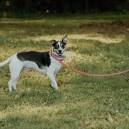Soldiers with JBLM Veterinary Treatment Facility busy caring for military dogs, cats
March 03, 2011 • Health & Wellness • Rescue •
By: Lorin T. Smith/Northwest Guardian
One Joint Base Lewis-McChord clinic caters to a special clientele, one with four legs that pants, fetches and provides years of loyalty to its owners.
Some even help heal their masters, but in turn, require their own medical attention to stay in shape.
Tucked away in the dense McChord Field woods near the Whispering Firs Golf Course is a clinic that treats nearly 6,000 animals a year. While that may not seem like a lot compared to the number of humans walking through the doors of Madigan Healthcare System’s clinics or the Airman’s Clinic at McChord Medical Clinic, in animal terms, it represents a lot of dogs and cats.
The bustling JBLM Veterinary Treatment Facility in Building 768 on Warehouse Road treats dogs and cats exclusively. The staff now makes more appointments than ever, thanks to the thousands of Soldiers and Airmen returning from deployments to the installation in 2010, said Sgt. Rita Jo Stewart, the veterinary NCOIC
The clinic is typically packed, especially if any of the more than 350 military working dogs providing force protection or therapy to active-duty servicemembers comes in for an exam or an emergency.
“(Military working dogs) take a higher priority and that’s not necessarily understood,” Stewart said.
One unfortunately named female enjoys the attention she commands.
Butch routinely heads to a clinic sandbox to do her duty, but in less than a month, the 22-month-old black Labrador will be heading for duty to the sandbox of Iraq with the 98th Combat Stress Control Detachment. There she will provide much-needed stress-relief therapy for Soldiers suffering from a traumatic brain injuries, post-traumatic stress disorder or a number of other injuries.
Before Butch can head downrange though, she, like all Soldiers preparing to deploy, had to be cleared by medical authorities. In this case, it wasn’t a doctor at Madigan Healthcare System, but a veterinarian at the JBLM Veterinary Treatment Facility.
“She’s looking pretty good,” said Capt. Alicia Gehling, the clinic’s officer in charge.
Therapy dogs like Butch come from nonprofit organizations like America’s VetDogs, which provides hundreds of dogs a year to military units, Warrior Transition Units or directly to veterans with individual needs. The dogs deploying to Iraq and Afghanistan go to behavioral health units to offer emotional support for servicemembers dealing with issues like combat stress, sleep disorders and problems at home. Like doctors, the dogs have clinical time as well as walk-abouts, when they meet Soldiers to provide on-the-spot therapy.
Butch soon replaces a combat-stress-control dog already in theater.
“The dogs love taking care of Soldiers and love their job,” said Valerie Cramer, a trainer with America’s VetDogs.
The organization donates the dogs to the Army, which saves taxpayers an average of $60,000 per dog. Handlers train the dogs for three to six months on stress control, physical therapy and occupational therapy. They also learn to respond to emergencies by alerting others if their owners experiences disease-related episodes like seizures due to epilepsy or diabetes.
America’s VetDogs provides dogs to veterans at no charge.
As valuable assets, the dogs don’t deploy without protection. Like servicemembers, the dogs wear ear and eye protection and carry backpacks filled with food and water. Fully mobile and ready to fight, they are trained to withstand the extreme noise at weapons ranges and to maneuver around helicopters on landing pads and zones.
“We give them an opportunity to have the best skills to utilize in theater, and the dogs are trained to the highest standard,” Cramer said. “They do their job, which is taking care of Soldiers.”
For more information, visit www.vetdogs.org or call 866-VETDOGS
More photos of the combat stress control dogs click on the following link: Combat stress control dogs receive care at McChord Field vet facility
Lorin T. Smith: lorin.smith@us.army.mil
Reprinted with permission of Chelsea Tafarella, Guide Dog Foundation for the Blind
Photography:
Ingrid Barrentine: ingrid.barrentine@us.army.mil








